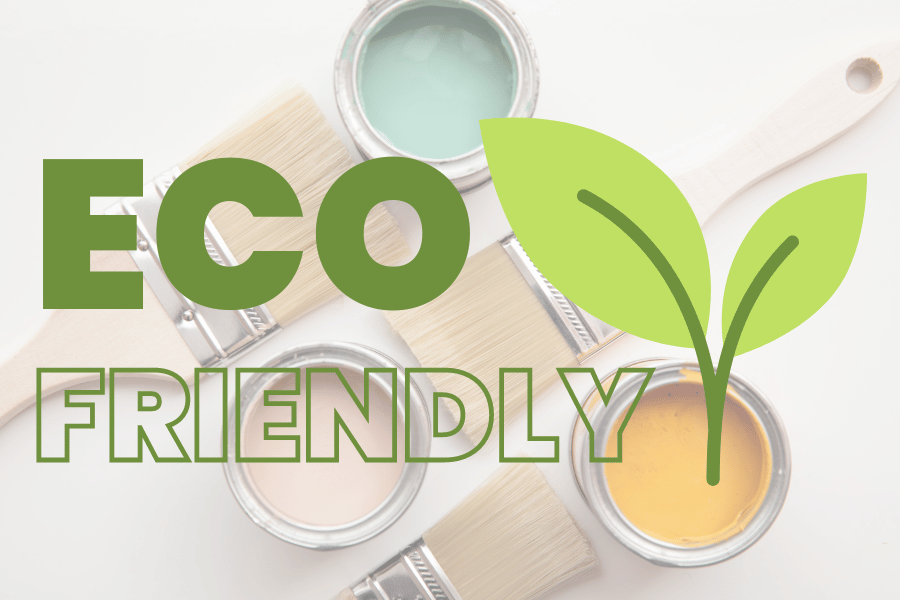In recent years, there has been a growing concern about the impact of traditional paints on our environment and health. Thankfully, eco-friendly paint options have emerged, offering a sustainable and healthier alternative. Choosing eco-friendly paint not only contributes to a greener planet but also promotes a healthier living environment for you and your loved ones.

In this blog post, we’ll guide you through the process of selecting the right eco-friendly paint for your next project.
Look for Low or Zero VOC Paints
Volatile Organic Compounds (VOCs) are chemicals commonly found in traditional paints, and they can be harmful to both the environment and human health. When selecting an eco-friendly paint, look for those labeled as low or zero VOC. These paints contain significantly reduced levels of harmful emissions, ensuring better indoor air quality and minimizing your carbon footprint.
Consider Water-Based Paints
Water-based paints are a popular choice when it comes to eco-friendly options. These paints are made primarily from water and natural pigments, with fewer harmful additives compared to oil-based counterparts.
Water-based paints have lower VOC levels, dry faster, and are easier to clean up with just soap and water. Moreover, they are suitable for various surfaces and offer a wide range of color options.
Seek Out Natural and Renewable Ingredients
To ensure your paint choice is truly eco-friendly, check the ingredient list for natural and renewable materials. Look for paints that utilize plant-based resins, such as linseed oil, soy, or citrus extracts. These ingredients not only minimize environmental impact but also provide added benefits such as durability and resistance to yellowing over time.
Verify Certifications
When purchasing eco-friendly paint, it’s essential to look for credible certifications and labels that validate the product’s sustainability claims. Some common certifications to watch for include Green Seal, Environmental Protection Agency’s (EPA) Safer Choice, and LEED (Leadership in Energy and Environmental Design). These certifications ensure that the paint meets specific standards for environmental friendliness and performance.
Assess Performance and Durability
While environmental considerations are crucial, it’s also important to select a paint that performs well and has good durability. Look for eco-friendly paints that offer excellent coverage, adhesion, and resistance to wear and tear. Read customer reviews and seek recommendations from professionals or friends who have used eco-friendly paint to ensure you choose a reliable product.
Explore Local and Small-Batch Options
Supporting local businesses and small-batch manufacturers is another way to make eco-friendly choices. Local producers often prioritize sustainable practices and may use locally sourced materials, reducing transportation emissions. Additionally, small-batch paints are often made in smaller quantities, minimizing waste and ensuring higher quality control.
Dispose of Paint Properly
Proper disposal of paint is essential to maintain eco-friendly practices throughout your project. Unused or leftover paint should be stored in airtight containers and recycled or donated whenever possible. Many communities have specific guidelines and recycling programs for paint disposal, so make sure to check with your local waste management authorities.
Choosing eco-friendly paint is a conscious decision that benefits both our environment and our health. By opting for low or zero-VOC paints, water-based formulations, natural ingredients, and certified products, you can create a sustainable and beautiful space without compromising on quality.
Remember to consider performance, durability, and disposal methods throughout the process. By making eco-friendly paint choices, you contribute to a greener future while enjoying a healthier living environment for yourself and generations to come.
So, let’s make the switch to eco-friendly paints and paint a brighter, more sustainable future together!
Carnival Custom Painting proudly serves Georgetown, Round Rock, Hutto, Cedar Park, Pflugerville, Leander, Liberty Hill, and North Austin.

Leave a Reply